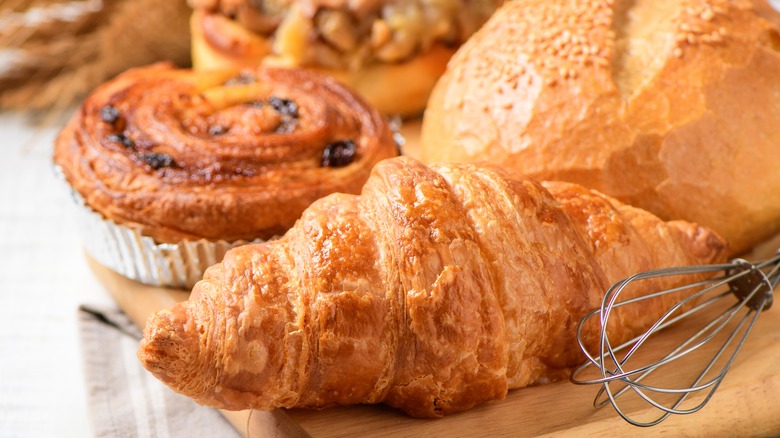What Makes Puff Pastry And Croissant Dough Different
Who doesn't love pastry? It's flaky and buttery — has there ever been a better pair of qualities? Pastry has a nearly endless list of potential uses, which range from sweet treats like the classic cream puff to savory dishes like pastry-wrapped sausage snack colloquially known as pigs in a blanket.
Though most of us have enjoyed pastry in one form or another, you might not be aware of the complex process that goes into making it. According to The Guardian, pastry dough is infused with a fat, oftentimes butter. Though the infusion itself can be an arduous process, it ultimately results in the pastry's unique texture, which we all know and love. Different ratios of fat to the other dough ingredients will ensure that your pastry ultimately achieves the right balance between tenderness and flakiness.
Two instantly recognizable pastry varieties are puff pastry and croissants. These two pastries have a lot of similarities, but the composition of their respective doughs has a few important differences.
Two types of laminated dough
According to MasterClass, both puff pastry and croissant dough are examples of laminated dough. Laminated dough is a complex creation that involves folding butter into pastry dough in a series of alternating layers. Rolling out your dough and allowing it to rest after each individual fold will result in a flaky, layered final product with a rich, buttery flavor in every bite.
The difference between the two types of dough comes down to their ingredients. Pastry dough has fewer ingredients. Before being folded with fat, the dough consists of just flour, water, and salt, per MyRecipes. Croissant dough also features all of these ingredients, but brings yeast and milk into the mix. These distinct combinations give you two very different pastries. Puff pastry is more crispy. During the baking process, after the dough undergoes its namesake puff, it cooks all the way through, resulting in a crunchy pastry. The addition of milk in croissant dough richens it, and the yeast causes the dough to rise considerably, which is why the croissant has a more tender interior than puff pastry.
The science of cooking pastries
Those of you who have spent any amount of time baking may wonder how puff pastry is able to rise at all without the inclusion of any leavening agents. Montana Public Radio explains that the puffing happens when the liquid present in the dough turns into steam during the baking process. However, the science of baking puff pastry is far from simple. There are a number of things you can do wrong while making puff pastries. You need to roll out puff pastry to the appropriate thickness — if the dough is too thin, it will tear.
Chef Dominique Ansel, working with MasterClass, painstakingly describes the intricate process of making homemade croissants. Among other tips, he tells us that too much moisture in your dough results in an excessively chewy croissant. Before you bake the delicate dough, there are a number of foods you can stuff inside your croissant, including fruits, chocolate, or almond paste, if you're looking for something sweet. There are also savory fillings, like bacon, or spinach and feta.


